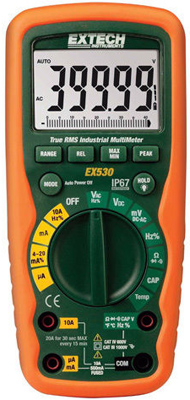
|
|
The Extech EX530 Heavy Duty True RMS Industrial MultiMeter has a 40,000 count large LCD display, temperature function and waterproof housing. AC/DC Voltage & Current, Resistance, Capacitance, Frequency, Temperature, Duty Cycle, Diode/Continuity. Dual sensitivity frequency functions (electrical/electronic). Specifications. DC Voltage Ranges: 400mV, 4V, 40V, 400V, 1000V. DC Voltage Maximum Resolution: 0.01 mV. DC Voltage Accuracy: ± 400mV, 4V, 40V, 400V ±(0.06% reading + 2 digits), 1000V ±(0.1% reading + 2 digits). AC Voltage Ranges: 400 mV, 4V, 40V, 400V, 1000V. AC Voltage Maximum Resolution: 0.01 mV. AC Voltage Accuracy (50 to 1000Hz): 400 mV ±(1.0% reading + 4 dgts), other ±(1.0% reading + 3 digits). DC Current Ranges: 400µA, 4000µA, 40mA, 400mA, 10A. DC Current Maximum Resolution: 0.01 µA. DC Current Accuracy: ±(1.0% reading + 3 digits). AC Current Ranges: 400µA, 4000µA, 40mA, 400mA, 10A. AC Current Maximum Resolution: 0.01 µA. AC Current Accuracy (50 to 1000Hz): ±(1.5% reading + 3 digits). Resistance Ranges: 400, 4k, 40k, 400k, 4M, 40Mohm. Resistance Maximum Resolution: 0.01 ohm. Resistance Accuracy: 400 ohm ± (0.3% reading + 9 digits), 4k, 40k, 400k, 4M ± (0.3% reading + 4 digits), 40Mohm ± (2.0% reading + 10 digits). Capacitance Ranges: 40 nF, 400 nF, 4 µF, 40 µF, 400 µF, 4000µF, 20mF, 40mF. Capacitance Maximum Resolution: 0.001 nF. Capacitance Accuracy: 40 nF, 400 nF ±(3.5% reading + 40 digits), 4 µF, 40 µF, 400 µF ±(3.5% reading + 10 digits), 4000µF, 20mF ±(5% reading + 10 digits). Frequency (electronic): 0.001Hz to 100 MHz. Frequency (electronic) Accuracy: ±(0.1% reading + 1 digits). Frequency (electrical): 40Hz to 400Hz. Frequency (electrical) Accuracy: ±(0.5% reading). Duty Cycle: 0.1% to 99.90%. Duty Cycle Maximum Resolution: 0.01%. Duty Cycle Accuracy: ±(1.2% reading + 2 digits). Temperature Ranges: -50 to 1382°F (-45 to 750°C ). Temperature Maximum Resolution: 1°F/°C. Temperature Accuracy: ±(3.0% reading + 2.5°C /4.5°F) (probe accuracy not included). Diode Test: Test current of 0.9mA typical, open circuit voltage 2.8V DC typical. Continuity Check: Audible signal will sound if the resistance is less than 35 ohm (approx.), test current <0.35 mA. Display: 40,000 count backlit liquid crystal with bargraph.
|